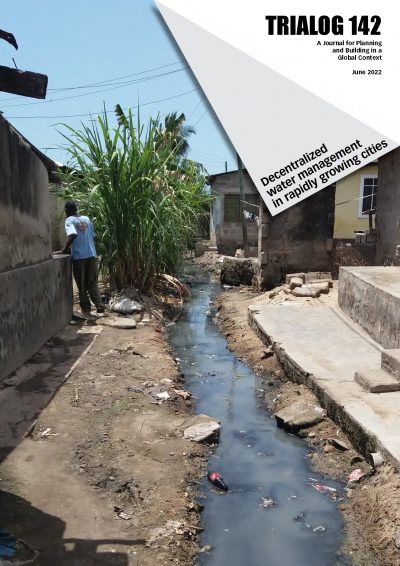The number of people living in cities is projected to increase by 50% from 4 to 6 billion between 2016 and 2045. Much of this growth is occurring in low-income and lower middle-income countries. In these rapidly growing cities of the Global South, pressure on water availability is increasing while a changing climate and inadequate infrastructure are posing significant challenges to their resilience. Observations and global climate models show robust increases in extreme daily precipitation over the past decades, while climate projections show continued intensification of this phenomenon. The increase of rainfall intensity and frequency will raise the risk of flash flooding. However, this will not necessarily lead to less droughts as climate change also leads to extended dry seasons and increased evapotranspiration causing insufficient water availability to sustain economic activities.
Currently available infrastructure will not be able to cope with the challenges of fast urbanization and climate change. Apart from flooding and water scarcity, rapid urbanization also contributes to an increasing sanitation crisis. Globally, 3.6 billion people live without access to safely managed sanitation and 44% of household wastewater is not safely treated. The interlinked challenges of urban land use change, increased water demand, pollution of water sources, changing precipitation patterns and increasing climate extremes draw attention to the need of a shift in urban water management and urban development that can contribute to healthy and resilient communities, and at the same time leverage benefits from synergies, such as treatment by-products or multiple-usage of spaces. Within this TRIALOG Issue we present and discuss approaches that contribute to water-sensitive urban design (WSUD) and citywide inclusive sanitation (CWIS).
We start the series of articles with the topic of equity in water distribution during the Day Zero Crisis in Cape Town, South Africa. N. Francisco describes the factors that led to the moment where the city’s water supply was about to collapse and the effects this had on equity.
F. Tapia demonstrates microclimate benefit of green infrastructure by analysing the impacts of neighbourhood-scale green roof implementation for air temperature reduction and thermal outdoor comfort in the industrial area of Bolzano, Italy. The article demonstrates the application of green roofs and further applies models and simulation for microclimate analysis. As such, the article presents solutions which have potential to be transferred to urban areas with similar climatic conditions in the Global South.
The article presented by J. Anterola focuses on the learnings of incorporating building and plot-level WSUD from built, successful projects in Singapore and the transfer of these learnings to an in-progress development of the BRAC University Campus located in Dhaka, Bangladesh. The presented projects enable the multiple usage of spaces, among others for recreation, onsite water management and the provision of niches for ecosystems.
H. Gupta, D. Prisanto, D. Ginting and F. Fladerer analyzed the governance capacity framework to sustain maintenance of community-based wastewater treatment facilities with a focus on two cities in Indonesia. The authors identified that the participation of private stakeholders and effectiveness of policy instruments relevant to maintenance and governance are limited and, therefore, define opportunities for improvement.
A. Schmidt, A. Edathoot, J. Camargo and A. Hodgson present and discuss a cluster approach for scaling up decentralized sanitation. The authors demonstrate the methodology based on their experiences from three case studies in Afghanistan, Tanzania and Laos. Clustering decentralized sanitation systems was found to have high potential for bridging this gap and assisting cities in incrementally and progressively reaching sanitation coverage and institutional capacity.
In our final article we present the findings of T. Fettback and J. Young, who compiled experiences made with private sector participation (PSP) for faecal sludge management (FSM) in Dar es Salaam, Tanzania. The case studies are based on project reports, students’ theses, and participation in project implementation, and are discussed by applying findings from literature review and sector conferences. The authors show opportunities and challenges experienced while piloting a variety of PSPs in different segments of the sanitation service chain.
Wolfgang Dickhaut, Ajith Edathoot, Tim Fettback, Mahmoud Moursy
Inhalt
- 04. (In)Equity in Water Distribution during the ‘Day Zero’ Crisis, Cape Town Nadia M. A. Francisco
- 14. Greening Impact on Urban Industrial Microclimates. A Case Study in Bolzano Francisca Tapia
- 24. Prototyping WSUD Tools in Southeast Asia. BRAC University Campus, Dhaka, Bangladesh Jeremy Karl Anterola
- 33. Analysis of the Governance Capacity Framework to Sustain the Maintenance of Community-based Wastewater Treatment Facilities. Lessons Learnt from the Cities of Sleman and Blitar in Indonesia Ida Bagus Hendra Gupta, Denny Eko Prisanto, Dona Saputra Ginting and Frank Fladerer
- 40. Cluster Approach for Scaling up Decentralised Sanitation. A Paradigm Shift in Sanitation Planning Andreas Schmidt, Ajith Edathoot, Jutta Camargo and Adrian Hodgson
- 47. Lessons Learnt from Private Sector Participation for Improved Faecal Sludge Management in Dar es Salaam, Tanzania Tim Fettback and Jonathan Young
- 57. Book reviews
- 59. Editorial (Deutsch): Dezentrales Wassermanagement in schnell wachsenden Städten

